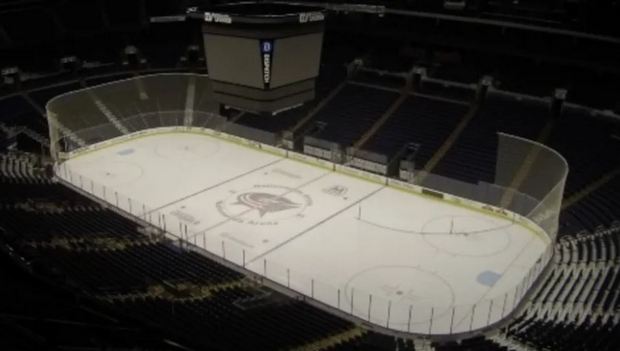Columbus (Ohio) Blue Jackets to Be First NHL Team to Use CO2-Based Ice Rink System

The Columbus Blue Jackets, which joined the National Hockey League (NHL) in 2000, will become the first NHL team to skate on ice produced by a transcritical CO2 (R744)-based ice rink refrigeration system.
The system, to be supplied by Canadian manufacturer and contractor CIMCO Refrigeration, will be installed next year at Nationwide Arena (the purchaser of the system) in Columbus, Ohio, in time for the Blue Jacket’s 2023-2024 NHL season. The indirect system will use CO2 as the primary refrigerant and glycol as the secondary coolant under two rinks, the main NHL rink and a practice rink.
The system consists of two 200TR (703kW) industrial-grade CO2 packages, each consisting of eight compressors. It also features a seven-pump package for pumping glycol under the two rinks and for heating. The system supplies 5°F (-15°C) glycol for the ice rinks per NHL requirements, and “can go lower if needed,” said Brad Wilkins, U.S. Recreation Project Team Lead at CIMCO Refrigeration. It includes redundant components in the event of a failure.
Fifteen of the NHL’s 32 rinks use another natural refrigerant – ammonia – in their ice rink systems. Among the rest, 15 (including Nationwide Arena currently) employ R22 or other traditional f-gases, while two use the HFO blend R513A.
Advantages of a transcritical CO2 (R744) ice rink cooling system compared to a R513A system
- The CO2 system turned out to be 25% less expensive than the R513A system, which required a special design for glycol piping and installation in the engine room.
- Another important advantage of the CO2 system is energy savings. The heat reclaim made possible by the system will be used to preheat hot water and to support snowmelt and underfloor heating. An R513A system would have required an additional natural gas boiler to deliver heat for snowmelt and underfloor heating.
- In addition, an analysis of electricity usage found that the CO2 system “conservatively” is expected to save 20% compared to an R513A system.
- The CO2 system will use two Guentner adiabatic gas coolers to bolster its energy efficiency during warmer days. Overall, the water used by the gas coolers will be far less than that used by a cooling tower for an R513A system, a projected savings of $20,000 per year.
Nationwide opted for an indirect CO2 system – rather than a direct CO2 system that would use CO2 under the two ice rink floors to take advantage of its existing glycol piping and floors. The lifespan of an ice rink floor and piping is 45 to 50 years, meaning that the 22-year-old floors at Nationwide are only middle-aged.
